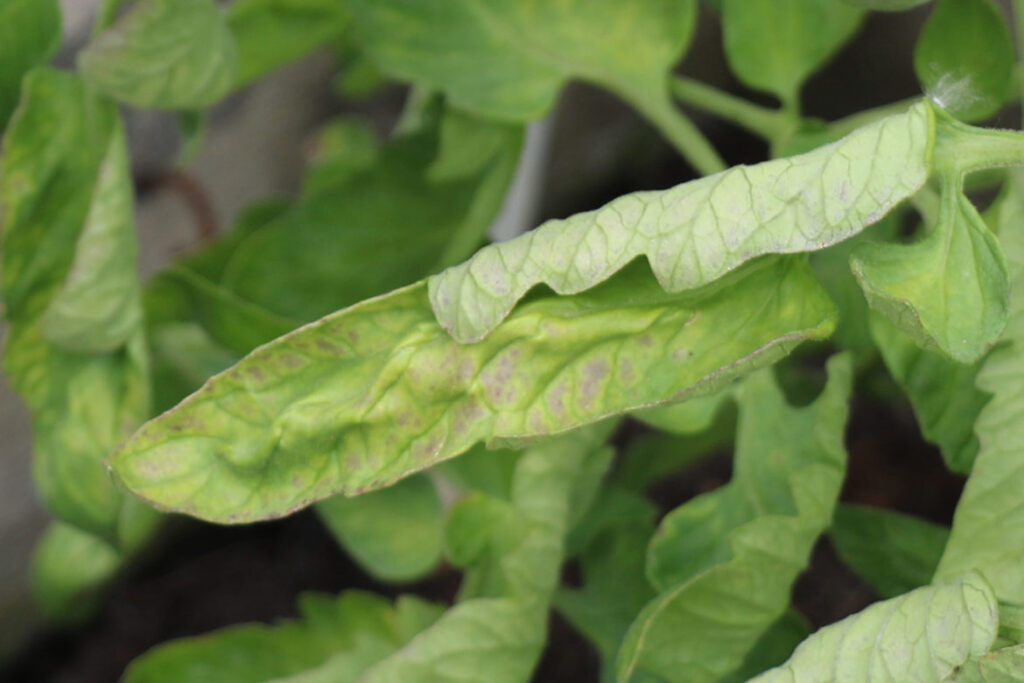Last updated on October 23rd, 2023 at 08:31 pm
Tomatoes come in a wide variety of colors, from red to yellow and even brown, everything is represented. However, they all have in common that their foliage is usually colored green. Sometimes, however, it happens that the tomato leaves turn purple. Of course, this is not typical, but rather represents a warning signal. We clarify why the tomato leaves turn purple and what to do in this case.
Contents
Phosphorus deficiency
Most often, reddish-purple tomato leaves can be attributed to a phosphorus deficiency. This deficiency can occur due to various causes: Firstly, when there is simply too little phosphorus in the soil. On the other hand, when phosphorus uptake is impaired. This can be the case, among other things, if the air and soil temperatures are too low. Likewise, the pH value of the soil plays a significant role, because if it is too high or too low, phosphorus uptake is also impaired.
Symptoms and treatment
Phosphorus deficiency is manifested not only in the form of reddish-purple leaves and stems, but also in scanty growth and low fruit set. In addition, flower and root formation is affected by phosphorus deficiency. To best address the phosphorus deficiency, the cause should first be determined:
- Check temperature
- check the pH value of the soil
- fertilize with phosphorus
- preferably inorganic phosphates in ionic form
- these are more easily absorbed
Low temperatures
Tomatoes like it sunny and warm – and at any stage of ripening. While young tomato plants can cope with lower temperatures (around 13 – 15 degrees) after planting, they prefer temperatures of 18 – 25 degrees during ripening.
If the tomato plants are too cold, this often manifests itself initially in purple leaves. However, if the plants are exposed to temperatures that are too low for a longer period of time, harvest losses are usually to be expected. This is because both pollination and fertilization fail to occur. In addition, plant growth is disrupted and the development of roots is impaired. To protect tomatoes from the cold, you can proceed as follows:
- in the greenhouse heat, for example: with frost monitor.
- in the open field protect tomatoes with fleece or tomato cover
- bring balcony tomatoes indoors
Wrong pH-value
The substrate or soil plays an essential role in the growth and health of tomatoes. Ideally, the substrate should be as loose and permeable as possible so that the tomato plants can easily absorb the nutrients it contains. Likewise, they prefer a soil with a pH of 6.5 – 7. However, if the soil is too acidic or too alkaline, this can impair nutrient absorption. Among other things, this inhibits phosphorus uptake, so that a phosphorus deficiency subsequently occurs.

Therefore, when purple leaves appear, it is advisable to check the pH of the soil and, if necessary, perform the following steps:
- Lower pH: peat, compost, mulch layer or coffee grounds.
- Raise pH: Potassium hydroxide, potassium bicarbonate or ground lime.
- Psyllids
A phosphorus deficiency is not always the reason for the purple coloration of tomato leaves. Because now and then pests are also responsible for the discoloration, namely so-called psyllids. These are tiny insects, also known as “leaf fleas” or “leaf suckers”. Although the name suggests that they are fleas, psyllids are actually beetles. Usually they occur in large numbers and can lead to the death of tomato plants in case of heavy infestation.
Symptoms and treatment
In the early stages, infestation is noticeable by a slight yellowing and/or purple discoloration of the upper leaves. Likewise, the leaves may curve slightly upward. In severe infestations, the entire upper surface of the tomato plants usually turns a purplish red, but sometimes a yellowish green. However, a psyllid infestation can be effectively controlled and prevented:
- Use natural enemies
- e.g.: Spiders, soft bugs, ladybugs and ichneumon wasps.
- remove infested leaves
- use insecticides in case of heavy infestation


